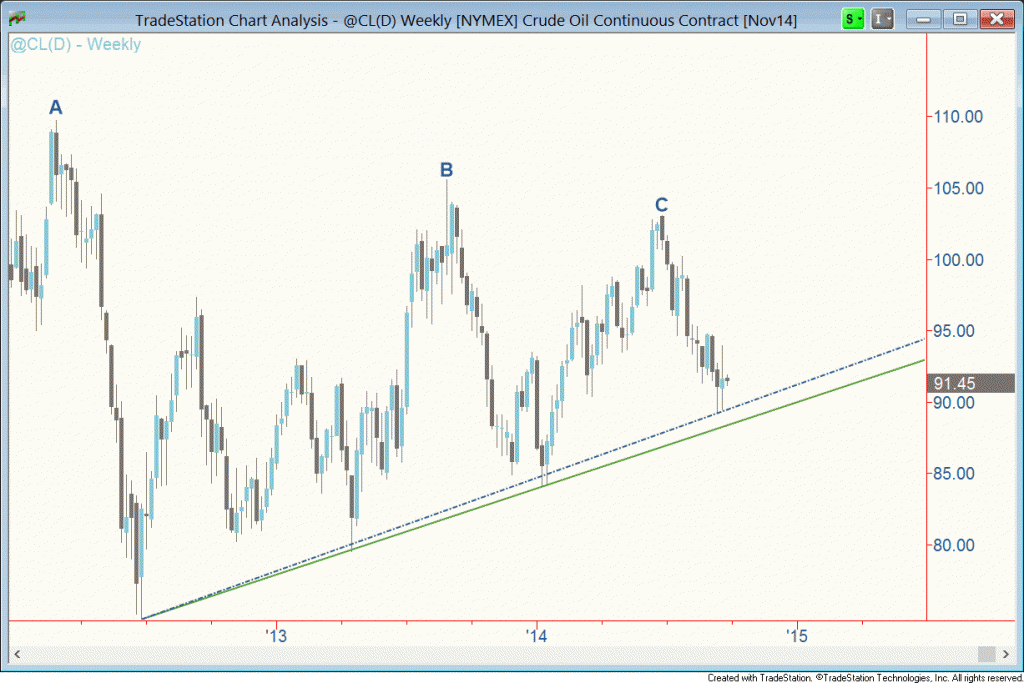The commodities sector has been hit hard by a stronger US Dollar and Crude Oil hasn’t been spared. But perhaps the decline in select commodities like Crude Oil is nearing an end. On September 15th, I wrote a piece for See It Market arguing that it was time to cover short positions in WTI crude oil futures (or related exchange traded products). Since that post, three key pieces of technical evidence have emerged pointing to an attractive reward-to-risk scenario for traders positioning for a Crude Oil reversal. In short, the recent downtrend in this market may be nearing an end.
As you are likely aware, commodities are pretty volatile. So before reading any further, I hasten to remind you to know what kind of trader you are. Contrarian trades inherently entail greater risk than trades in the direction of the trend. If you aren’t comfortable positioning for reversals, you’d do better to move to the sidelines for now.
Below is a three year weekly chart of Crude Oil. This will serve as a reference for the remainder of this post.
Crude Oil Weekly Chart
As you can see in the chart above, Crude Oil has experienced quite a few price swings over the past three years or so. So what makes this move lower attractive for a trader looking for a reversal? Here are 3 reasons:
1. The first development is an improvement in the price action, as illustrated by the weekly candlesticks. A lower shadow two weeks ago showed price weakness attracted buying. Last week another lower shadow appeared, along with an upper shadow (price strength attracted selling). The result is what’s called a high-wave candle. It implies a state of confusion or, put another way, a lack of consensus about the market’s direction. The high-wave candle tells us the downtrend has stalled and a reversal is possible. The textbook rule in this situation is to wait for a weekly close above last week’s high to confirm a reversal. But waiting that long to initiate a trade would put price well above a reasonable stop loss level and amount to chasing a train that had already left the station.
2. Next, those two candles were also fairly close to trend line support drawn off the lows going back to 2012 (green line). It would have been more satisfying if price actually touched that line, but we have to work with what the market is giving us, not perfect little boxes that make it nice and easy for us (those are usually the ones that fail anyway, in my experience). I drew the blue dashed line to show what it would look like if the market turned up here. It wouldn’t be a stretch for that to end up being the floor under the market.
3. A third point concerns the magnitude of Crude Oil’s recent decline. The downtrend from peak C to the low two weeks ago was pretty close to a 61.8% retracement of the decline from peak B. That downtrend was 61.8% of the fall from peak C. Retracing 61.8% of a prior trend achieves a proportional balance in the price structure that accords with the Fibonacci sequence. If you’re not familiar with Fibonacci analysis, think of it this way: trends tend to be proportionally related to prior trends, and in the past two weeks WTI came to a natural place for a turn based on that tendency.
A reasonable place for a stop loss would be around 88.00. That’s sufficiently beneath the green trend line, allowing adequate breathing room while containing risk to a reasonable level. As for potential upside, I generally shy away from price targets and instead incorporate a trend-following approach. For example, if the market indeed rallied, pushing the 20-day simple moving average up, you could stay in the trade until that average turned back down again.
I’ll end this comment by reiterating that if you aren’t comfortable positioning for a reversal, simply wait and watch. If an uptrend does find its legs, you’d then look to buy dips. This would reduce reward potential but also reduce risk, as the odds are always better on trades that are in the direction of the trend.
No position in any of the mentioned securities at the time of publication. Any opinions expressed herein are solely those of the author, and do not in any way represent the views or opinions of any other person or entity.









